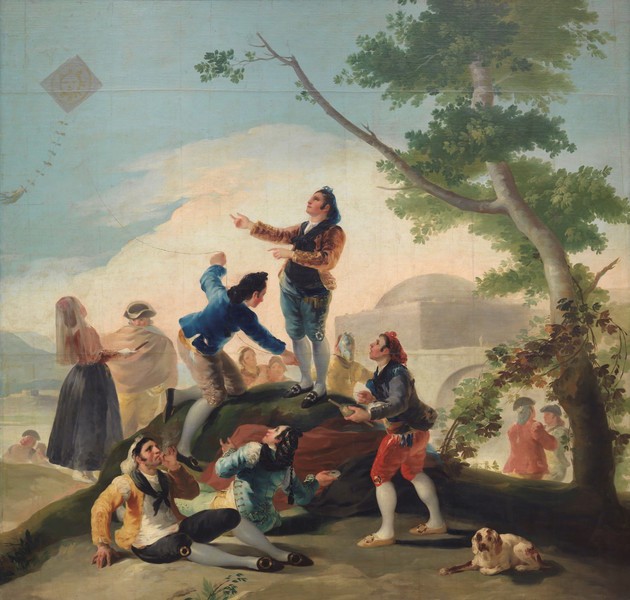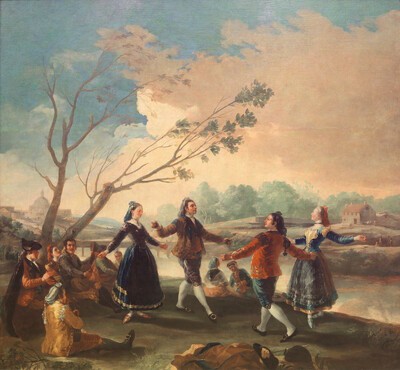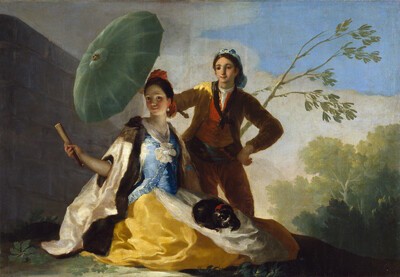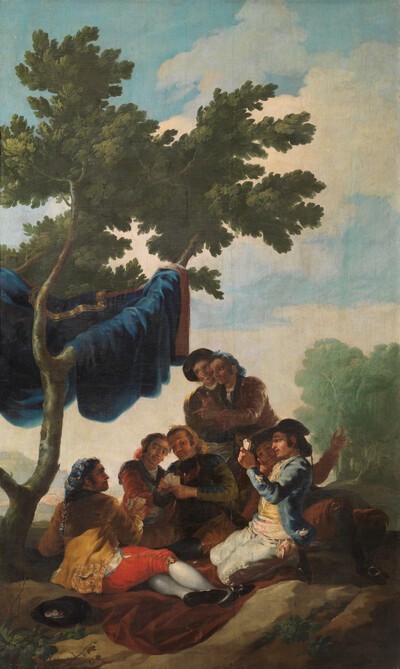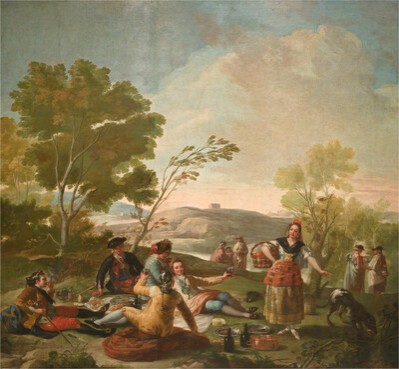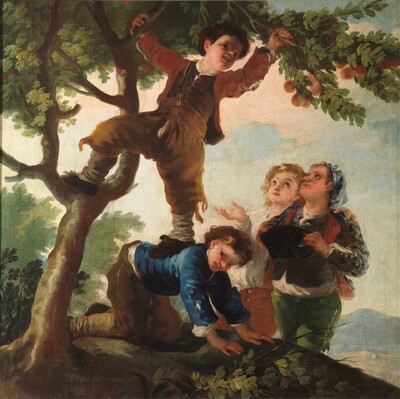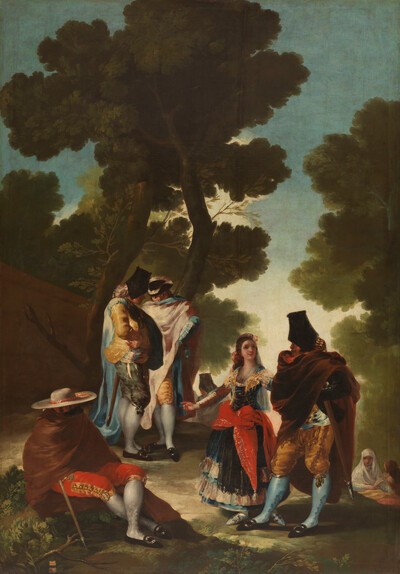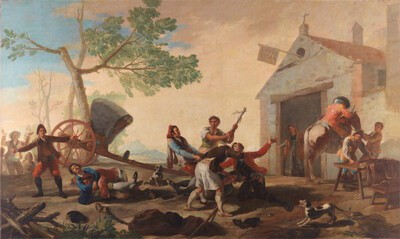- Cronología
- 1777 - 1778
- Ubicación
- The Prado National Museum. Madrid, Madrid, Spain
- Dimensiones
- 269 x 285 cm
- Técnica y soporte
- Oil on canvas
- Reconocimiento de la autoría de Goya
- Documented work
- Titular
- El Prado National Museum
- Ficha: realización/revisión
- 18 Nov 2009 / 14 Jun 2023
- Inventario
- (P00774)
This work forms part of the series of ten cartoons of country themes for tapestries designed to decorate the dining hall of the Prince and Princess of Asturias in the palace of El Pardo. Together with this cartoon, Goya delivered three more from the series: Card Players, Boys Inflating a Bladder and Boys Picking Fruit. They were made between 12 August 1777, the date of the previous delivery of cartoons to the Royal Tapestry Factory, and 26 January 1778, the date of this delivery.
Around 1856 or 1857, the cartoon was moved from the Royal Tapestry Factory of Santa Bárbara to the Royal Palace in Madrid. In 1870, it was taken to the Prado Museum under orders given on 18 January and 9 February.
The tapestry of this cartoon occupied the central portion of the north wall of the dining hall.
The composition of this work responds to the pyramid arrangement recommended by Mengs, a model that Goya had employed with success in other pieces in this series and which he would continue to use later. The work has a foreground with figures forming a pyramid, plus a second intermediate plane with figures that are semi-hidden by a mound and a background landscape, as in the pair of overdoor works, The Parasol and The Drinker.
and The figures in this leisure scene show a humanist approach that was to become one of Goya's defining characteristics. Four majos are flying a kite whilst a fifth sits smoking a cigarette. Other figures look on whilst another man only has eyes for the girl before him.
Attempts were made to identify the location as the hill of El Rastro, in Madrid, and the domed construction that appears in the background as San Francisco el Grande - by the architect Francesco Sabatini - when it was still in construction. However, this is impossible since in another cartoon in the series, Dance on the Banks of the Manzanares, delivered on 3 March 1777, Goya depicted this same building completely finished.
Elsewhere, it has been suggested that this building could be the observatory, the construction of which was being discussed at the time in the court of Charles III. The hypothesis of the observatory also adds weight to Tomlinson's reading of this cartoon, relating it to vanitas iconography and the futility of human knowledge. The kite, symbol of scientific experimentation, fits perfectly with this interpretation.
-
El arte de GoyaMuseo de Arte Occidental de TokioTokyo1971from 16th 1971 to January 23th 1972. Exhibited also at the Kyoto Municipal Museum of Art, January 29th to March 15th 1972.cat. 6
-
GoyaPalacio de PedralbesBarcelona1977from April 12th to June 30th 1977cat. 4
-
Goya. 250 AniversarioMuseo Nacional del PradoMadrid1996consultant editor Juan J. Luna. From March 29th to June 2nd 1996cat. 13
-
Goya en Madrid. Cartones para tapices 1775-1794Museo Nacional del PradoMadrid2014p. 291
-
L'œuvre peint de Goya. 4 volsBibliography']['numberParís1928-1950vol. I, p. 66, cat. 7
-
Tapices de GoyaBibliography']['numberMadridPatrimonio Nacional1946pp. 102, 212, cat. 16 y láms. 72-77
-
Vie et ouvre de Francisco de GoyaBibliography']['numberParísOffice du livre1970pp. 75, 86, cat. 81
-
Bibliography']['number
BarcelonaPolígrafa1970vol. I, p. 246, cat. 69
-
L’opera pittorica completa di GoyaBibliography']['numberMilanRizzoli1974pp. 94-95, cat. 76
-
Imagen de GoyaBibliography']['numberMadridLumen1983p. 69
-
Francisco de Goya, cartones y tapicescol. col. "Espasa Arte"Bibliography']['numberEspasa Calpe1987pp. 82-84, 152, 257, cat. 20C y 83 (il.)
-
Francisco de Goya, 4 vols.Bibliography']['numberZaragozaCaja de Ahorros de Zaragoza, Aragón y Rioja1980-1982vol. I, p. 90 y p. 120 (il.)
-
Francisco de Goya. Los cartones para tapices y los comienzos de su carrera en la corte de Madridcol. col. "Ensayos de Arte Cátedra"Bibliography']['numberMadridCátedra1987pp. 75-82, 86 y p. 77 (il.)
-
Goya. 250 AniversarioBibliography']['numberMadridMuseo del Prado1996pp. 293-294, cat. 13 y p. 83 (il.)
-
Salas del Palacio Real de El Pardo para las que se tejieron tapices sobre cartones de Francisco de Goya: identificación de las habitaciones y ajuste de las obras de Goya en los alzados de las paredesin HERRERO CARRETERO, Concha (curator, Tapices y cartones de Goya (catalogue of the exhibition organizated at the Palacio Real de Madrid, from may to june 1996)Bibliography']['numberMadridPatrimonio Nacional, Goya 96, Lunwerg1996p. 166 (il.)
-
Goya en Madrid. Cartones para tapices 1775-1794Bibliography']['numberMadridMuseo Nacional del Prado2014p. 291
